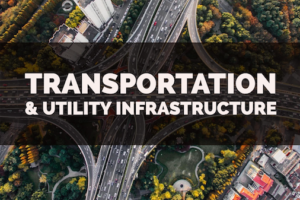
For companies deciding where to invest in new or expanded facilities, transportation and utility infrastructure are often top on the list of location factors. For this reason, Economic Development Organizations (EDOs) are well advised to know the details of local infrastructure and support ongoing investment in such, to ensure the community can compete for new investment.
Aligning Infrastructure with Investment Opportunities
No community can be all things to all projects. One project may require immediate access to a port, rail/truck intermodal facility, air cargo hub or an interstate highway, or maybe even all the above. For these projects, the list of candidate communities is instantly narrowed. Other projects may be less constrained by proximity of this type, but transportation and utility assets appropriate to every project are still required.
The site selection profession has advanced on many fronts over the years and as a result, site selectors are more closely scrutinizing transportation and utility infrastructure. Site selectors are likely to uncover system weaknesses during this investigation. It is incumbent on the EDO to know local transportation and utility infrastructure, inside and out, and address shortcomings straight away. It is better to admit weaknesses and explain remedies than try to sweep them under the rug.
Site selection veterans are replete with lessons learned and voice the refrain, “I won’t make that mistake again.” On a project in Michigan some years ago, a client selected the recommended site, started construction in the spring, and in late fall was ready to install massive industrial presses. The site was in a well-designed light industrial park, or so we thought.
As multiple trucks carrying heavy machinery made their way to the site, county road officials denied permits for the transport. It turns out, the industrial park road was not designed for four-season heavy load transport. Heavy loads were forbidden during frost season, November to March. The equipment was stopped a mile short of the building and the client’s head was ready to explode. The situation was resolved, but not before there was a significant investment of dollars, and uncompensated time spent by red-faced consultants.
The portfolio of location selection projects hovering over the land at any given time is highly variable, as are the associated transportation and utility requirements. So, how can economic developers know if their region is adequately prepared for transportation and utility needs of potential investments?
The short answer is they cannot. It is impossible for any one site or region to be all things to all industries. However, a thorough site competitiveness study conducted by an independent expert source can help EDOs determine which industries are best suited for their region and how competitive they are on a global, national and regional scale. A comprehensive study will include an assessment of site specific information such as utilities, transportation infrastructure, site characteristics and more – the results of which are used to determine site strengths, weaknesses, opportunities and threats. Knowing the top industries to target and site risks to be mitigated gives EDOs a deep knowledge of their region, a clear understanding of how competitive their location is, and a path forward to attract companies to their area.
If you have questions regarding your region’s transportation and infrastructure readiness, explore our membership to find a site selection consultant who can provide expert guidance.
Learn more about the co-authors of this blog post: Woody Hydrick & Don Schjeldahl
